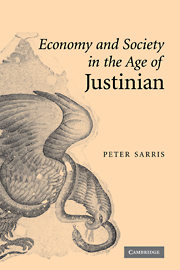Book contents
- Frontmatter
- Contents
- List of figures
- Preface
- Introduction
- 1 Egypt and the political economy of empire
- 2 The Apion archive: economic structure and estate accounts
- 3 Labour and administration: the evidence of the contractual papyri
- 4 Letters and petitions: social relations in the sixth-century Oxyrhynchite
- 5 The Apiones and their analogues
- 6 On the margins of magnate power: Dioscorus and Aphrodito
- 7 Landscapes of power: the great estate beyond Egypt
- 8 The historiography of the great estate
- 9 The great estate and the imperial authorities
- 10 The rise of the great estate
- 11 Economy and society in the age of Justinian
- Conclusion
- Bibliography
- Index
3 - Labour and administration: the evidence of the contractual papyri
Published online by Cambridge University Press: 24 July 2009
- Frontmatter
- Contents
- List of figures
- Preface
- Introduction
- 1 Egypt and the political economy of empire
- 2 The Apion archive: economic structure and estate accounts
- 3 Labour and administration: the evidence of the contractual papyri
- 4 Letters and petitions: social relations in the sixth-century Oxyrhynchite
- 5 The Apiones and their analogues
- 6 On the margins of magnate power: Dioscorus and Aphrodito
- 7 Landscapes of power: the great estate beyond Egypt
- 8 The historiography of the great estate
- 9 The great estate and the imperial authorities
- 10 The rise of the great estate
- 11 Economy and society in the age of Justinian
- Conclusion
- Bibliography
- Index
Summary
THE NATURE OF THE DOCUMENTS
Although the Apion estate accounts reveal in broad outline the economic structure of the family's Oxyrhynchite landholdings in the sixth century, they shed relatively little light on the precise terms on which the estate's labourers, supervisors, and managers were actually employed. For this aspect of the life on the Apion estates, we must turn to the testimony of the contractual papyri.
The major contractual components of the archive may be divided into three. First and foremost in terms of the light they shed on the management of the estates are the homologiai (ὁμολογιαί), which generally consist of contracts of employment. In many respects, the homologiai bear close resemblance to the contracts of surety, the enguai (ἐγγύαι), which constitute our second type, and which describe in greatest detail the terms on which the mainstay of the agricultural workforce was retained in the service of the household. Third are the cheirographiai (χειρογραφίαι), contracts acknowledging the receipt of items issued by the Apion estate to its employees and dependants. This third category shares certain affinities with other documents found within the archive of relatively minor significance to our understanding of the workings of the household. As such, these documents (styled apodeixeis/ἀπόδειξεις), along with documents of receipt termed idiocheira (ἰδιόχειρα) and grammateia (γραμμάτεια), are not examined here, although their existence should be noted.
- Type
- Chapter
- Information
- Economy and Society in the Age of Justinian , pp. 50 - 70Publisher: Cambridge University PressPrint publication year: 2006

